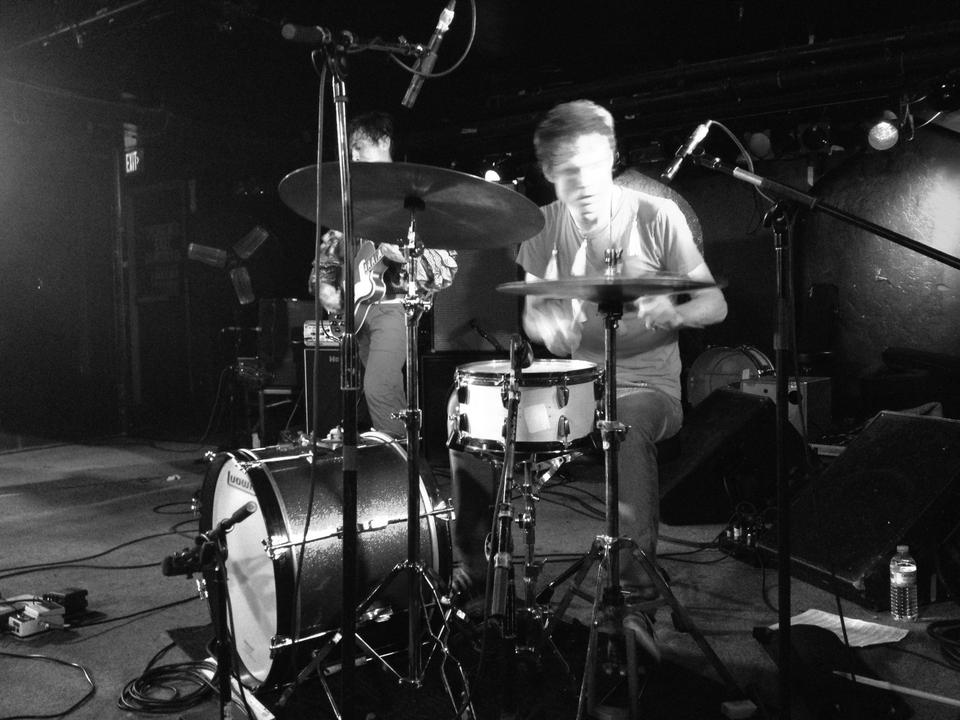
News
Summers Will Not Finish Semester of Teaching as Harvard Investigates Epstein Ties

News
Harvard College Students Report Favoring Divestment from Israel in HUA Survey

News
‘He Should Resign’: Harvard Undergrads Take Hard Line Against Summers Over Epstein Scandal

News
Harvard To Launch New Investigation Into Epstein’s Ties to Summers, Other University Affiliates

News
Harvard Students To Vote on Divestment From Israel in Inaugural HUA Election Survey
Order and Chaos Intersect at Middle East
Deerhoof and Buke & Gase perform

The Middle East Downstairs in Cambridge is known for playing host to a wide range of eccentric sights and sounds, and last Tuesday night was no exception. Homemade instruments, shirts with colorful tassels haphazardly glued on, free jazz voyages, and goofy arm-waving routines all played a role over the course of the evening. Brooklyn-based Buke and Gase and San Francisco-based Deerhoof shared the bill, and each captivated with their own brand of eccentricity. Buke and Gase delivered a superb set of stomping and frenetic music, while Deerhoof delighted with their energy and seemingly endless arsenal of musical styles.
The duo Buke and Gase performed sitting down, out of necessity. Aside from playing the self-invented ‘buke,’ a baritone ukulele, and ‘gass,’ a guitar/bass hybrid, lead singer Arone Dyer and instrumentalist Aron Sanchez each used their feet to operate a ‘toe-bourine’ and a kick drum.
The group’s multi-instrumentalism was impressive given the complex rhythmic and melodic lines each instrument produced. At times, Dyer simultaneously sang vocal lines with massive interval jumps while playing math rock riffs on her buke and tapping out arrhythmic accents with her toe-bourine. Buke and Gase’s impeccable musicality was especially on display during their performances of “Tending the Talk” and “Misshaping Introduction,” both off the band’s recently released EP “Function Falls.” The studio versions are complex to the point that the instruments seem overdubbed, so it was very impressive to see a faithful reproduction of them performed live.
While their performance skills are first-class, Dyer and Sanchez truly shine in their ability to compose a song. A typical Buke and Gase track incorporates a variety of distinct, challenging musical concepts in a way that feels natural and organized. Stylistically, Buke and Gase are similar to tUnE-yArDs and Dirty Projectors in their use of unusual intervals and phrasing in their vocal lines and their repetitive, building instrumental structures, although they treat their craft with more solemnity than either group.
Buke and Gase produced eminently danceable rhythms throughout their tight, 45-minute set, but the crowd at the Middle East was tame. Because the duo was seated, they interacted with the crowd very little. This, combined with recurring microphone amplifier issues, the fact that the band largely played material from an upcoming record (to be released in January), and the group’s seriousness, discouraged audience participation.
The mood changed instantly when Deerhoof took the stage half an hour later. The group ripped through several cuts off their latest record, “Breakup Song,” at torrential speeds. This harsh, driving style was somewhat unexpected, because “Breakup Song” is a poppy, electronic, and sonically-reserved album.
It probably shouldn’t have come as a surprise, though. Since their formation in San Francisco in 1994, the group has thrived on its willingness to experiment. Case in point: the group took on Japanese film student Satomi Matsuzaki as lead singer in 1996, even though she had no prior musical experience. Since gaining widespread recognition for their 2002 album “Reveille,” Deerhoof have reinvented their musical style on each subsequent album, incorporating noise rock, rockabilly, electronica, and jazz into an overall sound that is still unmistakably their own.
Because of this, Deerhoof’s live act felt constantly on edge and subject to rapid shifts in musical style, speed, and sonic intensity at the drop of a hat. Frequently, the group broke into loud, lengthy, and dissonant instrumental sections that felt entirely improvised, but they would just as quickly break back out of them into a bouncy chorus.
This give-and-take between order and chaos was best illustrated by the stage presences of guitarist Ed Rodriguez and drummer Greg Saunier. Rodriguez careened around the stage, hair whipping back and forth, and frequently dove into exploratory free jazz guitar interludes between songs. On the other hand, Saunier, who was dripping with sweat by the fourth song due to his furious drumming, frequently turned to the sound technicians and asked for slight adjustments for certain instruments. Rodriguez wanted concertgoers to wonder if the band had any idea what they were doing, but Saunier’s precise tweaking revealed the answer.
Deerhoof’s best songs were the ones that put the spotlight on Matsuzaki. During the band’s performance of “Flower,” Matsuzaki provided powerfully eerie vocals over the Sonic Youth-like verses and effortlessly shifted into a sunny, exhuberant chorus.
On the group’s final song of the night, “Basket Ball Get Your Groove Back,” Matsuzaki channeled a quirky Japanese rock style, leading the crowd in a hilarious sing-along of the track’s minimalist lyrics (“Basket ball Basket ball Basket/Dribble/Pivot Pivot Pivot Pivot/Escape”). The song was a fittingly outlandish close to a wonderfully strange night.
Want to keep up with breaking news? Subscribe to our email newsletter.
